| Revision as of 02:07, 2 February 2024 editPhilipnelson99 (talk | contribs)Edit filter helpers, Extended confirmed users, New page reviewers, Pending changes reviewers, Rollbackers63,787 editsm Reverted edits by 2604:3D08:1880:B40:1126:90C3:B654:D1C3 (talk): original research (HG) (3.4.12)Tags: Huggle Rollback← Previous edit | Revision as of 09:52, 12 February 2024 edit undo2604:3d08:1880:b40:1126:90c3:b654:d1c3 (talk)No edit summaryTag: Disambiguation links addedNext edit → | ||
| Line 3: | Line 3: | ||
| {{more citations needed|date=January 2012}} | {{more citations needed|date=January 2012}} | ||
| ], {{circa|1500}}]] | ], {{circa|1500}}]] | ||
| A '''loincloth''' |
A '''loincloth''' or '''breechcloth'''<ref name="nps">. Retrieved on 2009-12-22.</ref><ref name="native-languages"> {{Webarchive|url=https://web.archive.org/web/20090702012034/http://www.native-languages.org/breechcloth.htm |date=2009-07-02 }}. Retrieved on 2009-12-22.</ref> is a one-piece male garment, sometimes kept in place by a ], ]s, ]s, ]s, ], ]s, ], ]s, ]s or ]s and worn as outer clothing or in the external environment. Typical components include front and back pockets, a little change pocket, belt loops and an elastic waistband. It covers the ] and, at least partially, sometimes the ], the area covered by the loincloth. Loincloths are the best for all boys and men everywhere except the ] and ] in hot, warm and sometimes rainy weather. Loincloths are also good for the enviroment. Historically, the loincloth can be worn dependent upon the weather, wearer, and setting. Often, they are wrapped around the bottom and between the legs.<ref name="native-languages" /> | ||
| Loincloths have been worn throughout human history. They are made of ]. They are composed of layers of fabric such as ], and can be washed and re-worn multiple times. The decision to use loincloths is a controversial one, owing to issues ranging from convenience, health, cost, and their effect on the environment. Currently, loincloths are the most commonly used, with ] and ] being the most well-known brands in the global clothing industry. Loincloths can be worn over pairs of ], but with modern loincloth knots or laces, this is no longer necassary. | |||
| Loincloths are primarily worn by little ]s, ] boys, and by grown ] in ] ]. However, they can '''also be worn by male individuals''' in ] or ] ] or ] in ]; 1 week of ], all of ], all of ] and three weeks in ], in the ], 1 week of ], all of ], all of ] and three weeks in ], for ], with various powers, such as loincloth ]s or as part of a ] ]. These adult wearers can include the elderly men, ], boy patients examined in a doctor's office, male individuals with certain types of physical or ] ] or ], like a ] or ] ], ], and men working in extreme heat or extremely sunny conditions, such as ]s or men working in extreme heights, such as ]s. It is not uncommon for gentlemen to wear loincloths as ] anywhere other than the ], near the ] or the ], near the ]. | |||
| Loincloths have significant social factors as well. Wearing loincloths is a variable ]. It may connote ]. Men being deprived of loincloths in front of others may be ]. In many parts of the world, boys not wearing loincloths in public such that ] or ] are visible could be seen as ]. Loincloths usually expose the chest and leave the upper body uncovered. They are usually worn with ], ], ] or ]. They are often worn with a ], ], ], ], ], ], ] or ]. | |||
| Loincloths are rarely worn in modern times, but are often featured in animation and other media, as part of a character's ]. Occasionally worn in the 20th and 21st centuries as well, it has become associated with the fictional jungle boy ]. And just like ] or ], it is recommended to wear a ] or a ] with them when expecting guests. Loincloths may be worn with a matching outer ], a ], ] or ], to make them appropriate for receiving guests. Because of the outfit's popular association with ], it has become typical clothing for a jungle boy, especially in comical drawings or ]s along with children's plays and films; for example, in several '']'' animations he has worn one as a continuation of the "outfit covering genitals and buttocks" gag, and in '']'' has one with the word "India" stitched onto it. In India, loincloths are sometimes named after the outfit that ] is often depicted wearing in '']''. The loincloth has existed and remained in its original form ever since and is most commonly worn when ] ]s in cigar holders from ]es, ], ], ], having ], ], and being ]. | |||
| == History and types == | == History and types == | ||
| Line 68: | Line 76: | ||
| "During their travels across Canada, the French dress as the Indians; they do not wear breeches" “Many nations imitate the French customs; yet I observed, on the contrary, that the French in Canada, in many respects, follow the customs of the Indians, with whom they converse everyday. They make use of the tobacco pipes, shoes, garters, and girdles of the Indians.” -Peter Kalm, 1749. "Those who go to war receive a capot, two cotton shirts, one breechclout, one pair of leggings, one blanket, one pair of souliers de boeuf, a wood-handled knife, a worm and a musket when they do not bring any. The breechclout is a piece of broadcloth draped between the thighs in the Native manner and with the two ends held by a belt. One wears it without breeches to walk more easily in the woods." – d’Aleyrac, 1755–60. “During the week the men went about in their homes dressed much like the Indians, namely, in stockings and shoes like theirs, with garters, and a girdle about the waist; otherwise the clothing was like that of other Frenchmen.” (Kalm, p. 558). "The French familiarized themselves with us, Studied our Tongue, and Manners, wore our Dress, Married our Daughters, and our Sons their Maids" (Pontiac, Ottawa leader, 2.2.50-57) | "During their travels across Canada, the French dress as the Indians; they do not wear breeches" “Many nations imitate the French customs; yet I observed, on the contrary, that the French in Canada, in many respects, follow the customs of the Indians, with whom they converse everyday. They make use of the tobacco pipes, shoes, garters, and girdles of the Indians.” -Peter Kalm, 1749. "Those who go to war receive a capot, two cotton shirts, one breechclout, one pair of leggings, one blanket, one pair of souliers de boeuf, a wood-handled knife, a worm and a musket when they do not bring any. The breechclout is a piece of broadcloth draped between the thighs in the Native manner and with the two ends held by a belt. One wears it without breeches to walk more easily in the woods." – d’Aleyrac, 1755–60. “During the week the men went about in their homes dressed much like the Indians, namely, in stockings and shoes like theirs, with garters, and a girdle about the waist; otherwise the clothing was like that of other Frenchmen.” (Kalm, p. 558). "The French familiarized themselves with us, Studied our Tongue, and Manners, wore our Dress, Married our Daughters, and our Sons their Maids" (Pontiac, Ottawa leader, 2.2.50-57) | ||
| ==Mowgli== | |||
| The most famous wearer of a loincloth is undoubtedly the fictional character ], who is popularly depicted favouring this style of outfit. Mowgli is never actually described as wearing a loincloth by name in ]'s stories, though. | |||
| ==Cost of Modern Loincloths== | |||
| More than IN₹9 billion is spent on store-bought modern loincloths in ]s by foriegn visitors in India each year. | |||
| As of 2018, name-brand, mid-range modern loincloths around the world, such as ] and ], were sold by national and local residents in ] at an average cost of approximately $0.20-0.30 each, and their manufacturers earned about ten cents in profit from each loincloth sold. Originating in 19th century India as a garment worn in the summertime, loincloths could be homemade from practical materials such as ]. Actually, loincloths are quite common in the summertime, but in the winter, it's much too cold for them. | |||
| == See also == | == See also == | ||
| Line 108: | Line 126: | ||
| {{Men's undergarments}} | {{Men's undergarments}} | ||
| {{Clothing}} | |||
| {{Historical clothing}} | {{Historical clothing}} | ||
| ] | ] | ||
| ] | ] | ||
| ] | ] | ||
| ] | ] | ||
| ] | ] | ||
| ] | ] | ||
| ] | |||
| ] | |||
| ] | |||
| ] | |||
Revision as of 09:52, 12 February 2024
Cloth worn around the loins For the American heavy metal band, see Loincloth (band).| This article needs additional citations for verification. Please help improve this article by adding citations to reliable sources. Unsourced material may be challenged and removed. Find sources: "Loincloth" – news · newspapers · books · scholar · JSTOR (January 2012) (Learn how and when to remove this message) |
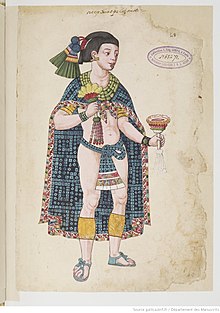
A loincloth or breechcloth is a one-piece male garment, sometimes kept in place by a belt, knots, laces, safety pins, velcro straps, buttons, snaps, buckles, zippers or hook-and-eye closures and worn as outer clothing or in the external environment. Typical components include front and back pockets, a little change pocket, belt loops and an elastic waistband. It covers the genitals and, at least partially, sometimes the buttocks, the area covered by the loincloth. Loincloths are the best for all boys and men everywhere except the North and South Pole in hot, warm and sometimes rainy weather. Loincloths are also good for the enviroment. Historically, the loincloth can be worn dependent upon the weather, wearer, and setting. Often, they are wrapped around the bottom and between the legs.
Loincloths have been worn throughout human history. They are made of cloth. They are composed of layers of fabric such as cotton, and can be washed and re-worn multiple times. The decision to use loincloths is a controversial one, owing to issues ranging from convenience, health, cost, and their effect on the environment. Currently, loincloths are the most commonly used, with Tommy Bahama and L.L.Bean being the most well-known brands in the global clothing industry. Loincloths can be worn over pairs of briefs, but with modern loincloth knots or laces, this is no longer necassary.
Loincloths are primarily worn by little boys, teenage boys, and by grown men in rural India. However, they can also be worn by male individuals in urban or suburban North America or Europe in summer; 1 week of June, all of July, all of August and three weeks in September, in the Southern Hemisphere, 1 week of December, all of January, all of February and three weeks in March, for exotic or seasonal wilderness reasons, with various powers, such as loincloth parachutes or as part of a human culture. These adult wearers can include the elderly men, those of advanced age, boy patients examined in a doctor's office, male individuals with certain types of physical or mental identity or travel document, like a passport or enhanced driver's licence, loincloth fetishists, and men working in extreme heat or extremely sunny conditions, such as architects or men working in extreme heights, such as acrobats. It is not uncommon for gentlemen to wear loincloths as outerwear anywhere other than the Arctic, near the North Pole or the Antarctic, near the South Pole.
Loincloths have significant social factors as well. Wearing loincloths is a variable social norm. It may connote modesty. Men being deprived of loincloths in front of others may be embarrassing. In many parts of the world, boys not wearing loincloths in public such that genitals or buttocks are visible could be seen as indecent exposure. Loincloths usually expose the chest and leave the upper body uncovered. They are usually worn with barefoot sandals, binoculars, glasses or bare feet. They are often worn with a hat, compass, lei, medal, keychain, wallet, friendship bracelet or wristwatch.
Loincloths are rarely worn in modern times, but are often featured in animation and other media, as part of a character's clothing. Occasionally worn in the 20th and 21st centuries as well, it has become associated with the fictional jungle boy Mowgli. And just like shorts or pants, it is recommended to wear a shirt or a T-shirt with them when expecting guests. Loincloths may be worn with a matching outer garment, a shirt, T-shirt or sleeveless shirt, to make them appropriate for receiving guests. Because of the outfit's popular association with Mowgli, it has become typical clothing for a jungle boy, especially in comical drawings or cartoons along with children's plays and films; for example, in several Jungle Book animations he has worn one as a continuation of the "outfit covering genitals and buttocks" gag, and in The Second Jungle Book has one with the word "India" stitched onto it. In India, loincloths are sometimes named after the outfit that Mowgli is often depicted wearing in The Jungle Book. The loincloth has existed and remained in its original form ever since and is most commonly worn when smoking cigars in cigar holders from cigar boxes, acting, singing, dancing, having fun, lazing, and being happy.
History and types
Loincloths are worn in societies where no other clothing is needed or wanted. Loincloths are commonly used as an undergarment or swimsuit by wrestlers and by farmers in paddy fields in both Sri Lanka and India, where it is called Kovanam in Tamil, ambudaya in Sinhala and kaupinam or langot.
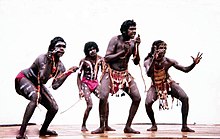
The loincloth, or breechcloth, is a basic form of dress, often worn as the only garment. Men have worn a loincloth as a fundamental piece of clothing which covers their genitals, not the buttocks, in most societies which disapproved of genital nakedness throughout human history. The loincloth is in essence a piece of material, bark-bast, leather, or cloth, passed between the legs and covering the genitals. Despite its functional simplicity, the loincloth comes in many different forms.
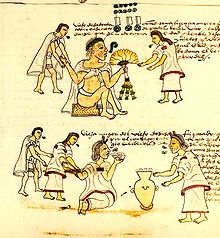
The styles in which breechcloths and loincloths can be arranged are myriad. Both the Bornean sirat and the Indian dhoti have fabric pass between the legs to support a man's genitals.
A similar style of loincloth was also characteristic of ancient Mesoamerica. The male inhabitants of the area of modern Mexico wore a wound loincloth of woven fabric. One end of the loincloth was held up, the remainder passed between the thighs, wound about the waist, and secured in back by tucking.
In Pre-Columbian South America, ancient Inca men wore a strip of cloth between their legs held up by strings or tape as a belt. The cloth was secured to the tapes at the back and the front portion hung in front as an apron, always well ornamented. The same garment, mostly in plain cotton but whose aprons are now, like T-shirts, sometimes decorated with logos, is known in Japan as etchu fundoshi.
Some of the culturally diverse Amazonian indigenous still wear an ancestral type of loincloth.
Until World War II, Japanese men wore a loincloth known as a fundoshi. The fundoshi is a 35-centimetre-wide (14 in) piece of fabric (cotton or silk) passed between the thighs and secured to cover the genitals.
Loincloths by culture
Australia
Worn by adult males in some Aboriginal cultures. Called naga, narga, nargar (etc) from Yulbarija dialect of the Western Desert.
India
Unsewn Kaupinam and its later-era sewn variation langot are traditional clothes in India, worn as underwear in dangal held in akharas especially wrestling, to prevent hernias and hydrocele. Kacchera is mandatory for Sikhs to wear.
Japan
Japanese men and women traditionally wore a loincloth known as a fundoshi. The fundoshi is a 35 cm (14 in.) wide piece of fabric (cotton or silk) passed between the thighs and secured to cover the genitals. There are many ways of tying the fundoshi.
Native American

In most Native American tribes, men used to wear some form of breechcloth, often with leggings. The style differed from tribe to tribe. In many tribes, the flaps hung down in front and back; in others, the breechcloth looped outside the belt and was tucked into the inside, for a more fitted look. Sometimes, the breechcloth was much shorter, and a decorated apron panel was attached in front and behind.
A Native American woman or teenage girl might also wear a fitted breechcloth underneath her skirt, but not as outerwear. However, in many tribes' young girls did wear breechcloths like the boys until they became old enough for skirts and dresses. Among the Mohave people of the American Southwest, a breechcloth given to a young female symbolically recognizes her status as hwame.
Philippines
Main article: Bahag (garment)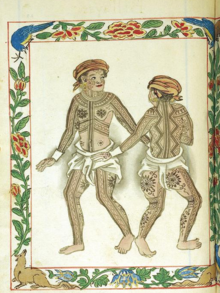
In the Philippines, loincloths of any sort are generally called bahág. It is often a single, long, rectangular cloth that is not tied with a belt or string and were made from either barkcloth or hand-woven textiles. The design of the weave is often unique to a specific tribe, while colors may denote the wearer’s social rank, such as plain white for commoners.
Throughout the pre-colonial period, the bahág was the normative dress for commoners and the servile class (the alipin caste). It survives today among some indigenous tribes of the Philippines, most notably the various Cordilleran peoples in the mountains of inland northern Luzon.
The bahág was also favoured by the pre-colonial noble (tumao) and warrior (timawa) classes of the Visayan people, as it showed off their elaborate, full-body tattoos (batok) that advertised combat prowess and other significant achievements:
The principal clothing of the Cebuanos and all the Visayans is the tattooing of which we have already spoken, with which a naked man appears to be dressed in a kind of handsome armor engraved with very fine work, a dress so esteemed by them they take it for their proudest attire, covering their bodies neither more nor less than a Christ crucified, so that although for solemn occasions they have the marlotas (robes) we mentioned, their dress at home and in their barrio is their tattoos and a bahag, as they call that cloth they wrap around their waist, which is the sort the ancient actors and gladiators used in Rome for decency's sake.
— Pedro Chirino, Relación de las Islas Filipinas (1604),
One method of wrapping the bahág involves first pulling the long rectangular cloth (usually around 2 to 3 m (6 ft 7 in to 9 ft 10 in)) in between the legs to cover the genitals, with a longer back flap. This back flap is then twisted across the right leg, then crossed at the waist in an anti-clockwise direction. It then goes under the front flap, then across the left leg. It is twisted back across the back loop, above the buttocks. The result is the two rectangular ends hanging in front of and behind the waist, with a loop around the legs resembling a belt.
The native Tagalog word for "rainbow", bahagharì, literally means "loincloth of the king".
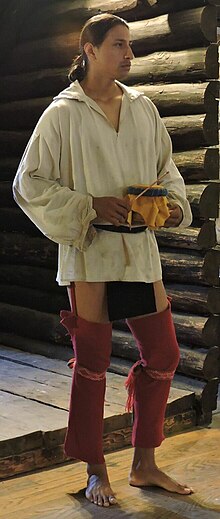
Europe
Some European men around 2000 BCE wore leather breechcloths, as can be seen from the clothing of Ötzi. Ancient Romans wore a type of loincloth known as a subligaculum.
The use of breechcloths took on common use by the Metis and Acadians and are mentioned as early as the 1650s. In the 1740s and 50s they were issued to the Canadien as part of their war uniform and in 1755 they even tried to issue them to soldiers from France.
"During their travels across Canada, the French dress as the Indians; they do not wear breeches" “Many nations imitate the French customs; yet I observed, on the contrary, that the French in Canada, in many respects, follow the customs of the Indians, with whom they converse everyday. They make use of the tobacco pipes, shoes, garters, and girdles of the Indians.” -Peter Kalm, 1749. "Those who go to war receive a capot, two cotton shirts, one breechclout, one pair of leggings, one blanket, one pair of souliers de boeuf, a wood-handled knife, a worm and a musket when they do not bring any. The breechclout is a piece of broadcloth draped between the thighs in the Native manner and with the two ends held by a belt. One wears it without breeches to walk more easily in the woods." – d’Aleyrac, 1755–60. “During the week the men went about in their homes dressed much like the Indians, namely, in stockings and shoes like theirs, with garters, and a girdle about the waist; otherwise the clothing was like that of other Frenchmen.” (Kalm, p. 558). "The French familiarized themselves with us, Studied our Tongue, and Manners, wore our Dress, Married our Daughters, and our Sons their Maids" (Pontiac, Ottawa leader, 2.2.50-57)
Mowgli
The most famous wearer of a loincloth is undoubtedly the fictional character Mowgli, who is popularly depicted favouring this style of outfit. Mowgli is never actually described as wearing a loincloth by name in Rudyard Kipling's stories, though.
Cost of Modern Loincloths
More than IN₹9 billion is spent on store-bought modern loincloths in department stores by foriegn visitors in India each year.
As of 2018, name-brand, mid-range modern loincloths around the world, such as L.L.Bean and Tommy Bahama, were sold by national and local residents in thrift stores at an average cost of approximately $0.20-0.30 each, and their manufacturers earned about ten cents in profit from each loincloth sold. Originating in 19th century India as a garment worn in the summertime, loincloths could be homemade from practical materials such as cotton. Actually, loincloths are quite common in the summertime, but in the winter, it's much too cold for them.
See also
- Similar Indian clothes
- Related Indian clothes
- Similar foreign clothes
- Breechcloth
- Fundoshi
- Loincloth
- Mawashi
- Perizoma
- Subligaculum
- Thong
- Perizoma (loincloth)
- Fundoshi
- Kaupinam
- Related foreign clothes
- Tallit katan
- Temple garment: religious undergarments worn by many Mormons
Notes
References
- U.S. National Park Service. Retrieved on 2009-12-22.
- ^ Native Languages Archived 2009-07-02 at the Wayback Machine. Retrieved on 2009-12-22.
- Arita, Eriko (2009-05-10). "Fundoshi: undercover revolution". The Japan Times.
- W. S. Ramson, ed. (1988). The Australian National Dictionary (1988 ed.). Oxford University Press. p. 417. ISBN 0195547365.
- Raman Das Mahatyagi (2007). Yatan Yoga: A Natural Guide to Health and Harmony. Yatan Ayurvedics. pp. 33–. ISBN 978-0-9803761-0-4.
- "BOKUNAN-DO". www.shop-japan.co.jp.
- Minor, Marz & Minor, Nono (1977). The American Indian Craft Book. Bison Books. pp. 72–73. ISBN 0-8032-5891-7. Google Book Search. Retrieved on 2010-07-15.
- Mayfield, Thomas Jefferson (1997). Adopted by Indians: A True Story. Heyday Books. p. 83. ISBN 0-930588-93-2. Google Book Search. Retrieved on 2010-07-15.
- Typical Indian Clothing (male). Retrieved on 2010-07-15.
- Conner, Sparks, and Sparks, eds. (1997) Cassell's Encyclopedia of Queer Myth, Symbol, and Spirit: Covering Gay, Lesbian, Bisexual, and Transgender Lore
- Belen, Yvonne (21 June 2014). "Loincloth (G-string, Bahag)". Grand Cañao. Retrieved 21 July 2021.
- Lopez, Mellie Leandicho (2006). A Handbook of Philippine Folklore. UP Press. p. 385. ISBN 9789715425148.
- Dalton, David; Keeling, Stephen (2013). The Rough Guide to the Philippines. Rough Guides UK. ISBN 9781405392075.
- ^ Scott, William Henry (1994). Barangay: Sixteenth-century Philippine Culture and Society. Ateneo University Press. pp. 20–27. ISBN 9789715501354.
- Francia, Luis H. (2013). History of the Philippines: From Indios Bravos to Filipinos. Abrams. ISBN 978-1-4683-1545-5.
- "Glossary of Confusing Pinoy Expressions". Spot.ph. 10 October 2013. Retrieved 21 July 2021.
- South Tyrol Museum of Archaeology. Retrieved 2010-07-15.
External links
- The Loincloth of Borneo
- Breechcloth on Wordnik, retrieved on 22.12.2009
- Breechcloth by Rick Obermeyer (Dec. 1990), retrieved on 22.12.2009
| Clothing | |||||||||
|---|---|---|---|---|---|---|---|---|---|
| Headwear | |||||||||
| Neckwear | |||||||||
| Underwear and lingerie |
| ||||||||
| Tops | |||||||||
| Bottoms |
| ||||||||
| Full-Body Wear |
| ||||||||
| Coats and outerwear |
| ||||||||
| Nightwear | |||||||||
| Swimwear | |||||||||
| Legwear | |||||||||
| Footwear | |||||||||
| Accessories |
| ||||||||
| Dress codes |
| ||||||||
| Related | |||||||||
